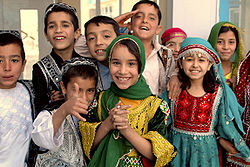
Clothing in Afghanistan consists of the traditional style of clothing worn in Afghanistan. The various cultural exchanges in the nation's history have influenced the styles and flavors of contemporary Afghan designs. [1] The styles can be subdivided into the various ethnicities with unique elements for each. Traditional dresses for both men and women tend to cover the whole body, with trousers gathered at the waist, a loose shirt or dress, and some form of head covering. [2] [3]
Contents
- Men's clothing
- Women's clothing
- Culture and society
- Politics
- Western and hippie appeal
- See also
- References
| Part of a series on the |
| Culture of Afghanistan |
|---|
 |
| History |
| People |
| Languages |
| Mythology |
| Cuisine |
| Festivals |
| Religion |
| Sport |



















